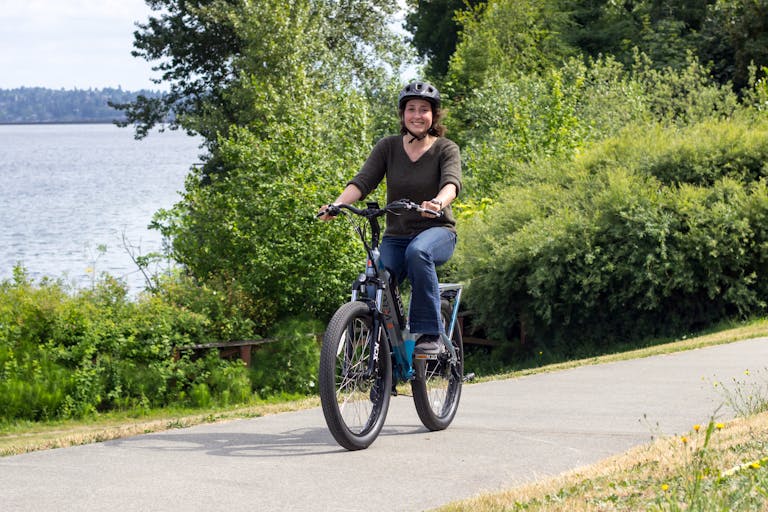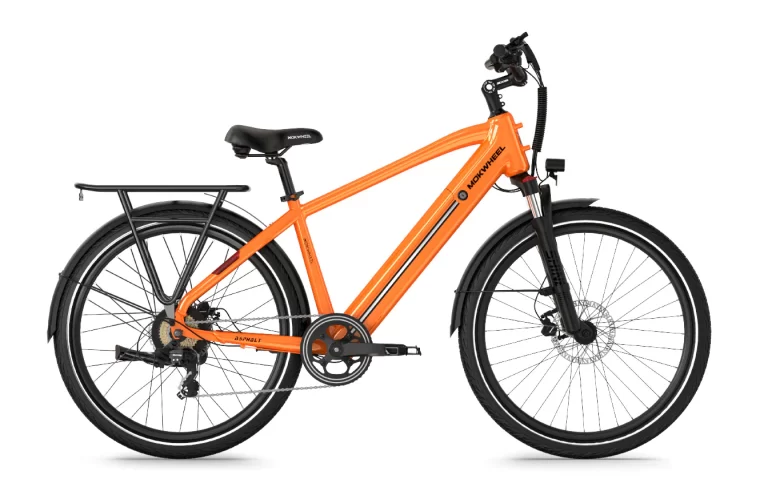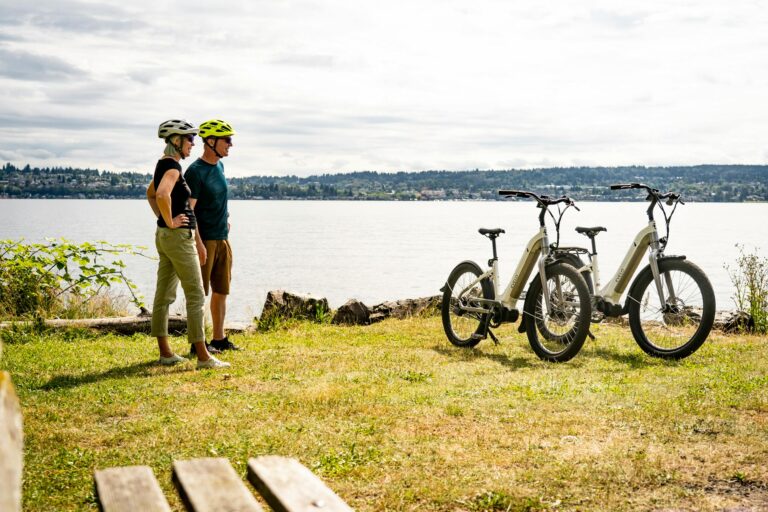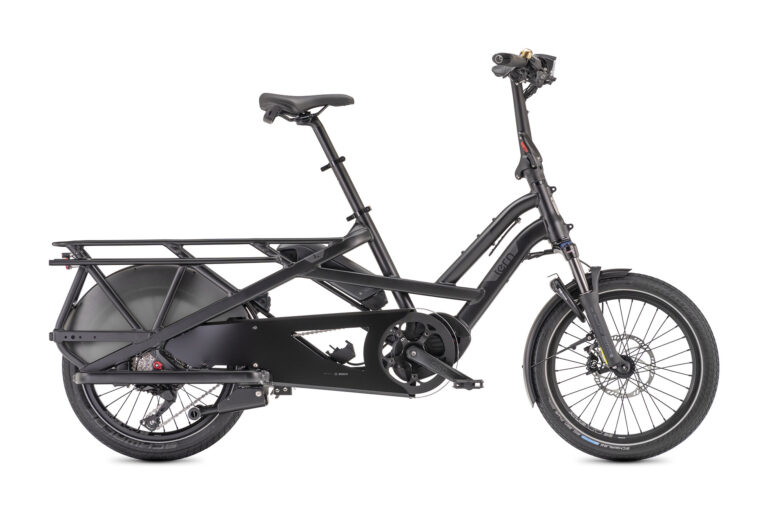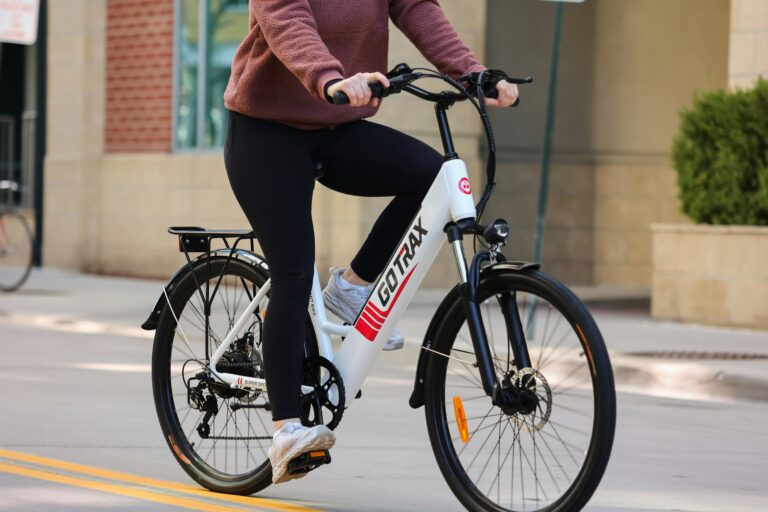Conquer Any Climb: E-Bike Climbing Techniques You Need to Know
E-bikes have become a game-changer in the cycling world. They’ve opened up the joy of cycling to a wider range of riders, from fitness enthusiasts to commuters and nature lovers. But even with the powerful assistance of an electric motor, tackling hills can still feel intimidating.
The good news is that conquering hills on an e-bike isn’t just about brute strength. By mastering a few key techniques and understanding how to use your electric assist system effectively, you can transform those daunting inclines into opportunities for exhilarating rides and scenic discoveries.
This guide dives deep into the world of e-bike hill climbing. We’ll explore essential techniques that will help you climb with confidence and efficiency, regardless of your fitness level. We’ll also delve into the intricacies of your e-bike’s assist system, explaining how to leverage its various settings to optimize your climbing experience. Whether you’re a seasoned cyclist transitioning to e-bikes or a complete newcomer eager to explore the world on two wheels, this comprehensive guide will equip you with the knowledge and skills to conquer any hill with a smile.
So, ditch the fear of hills and get ready to experience the full potential of your e-bike! With the right techniques and a little planning, you’ll be cruising up those inclines with newfound confidence and enjoying the breathtaking views that often lie just beyond the summit.
Key Takeaways
- Shift Down, Conquer Hills: Lower gears and a comfortable pedaling cadence are your allies for efficient climbing.
- Master Your Body Position: Lean forward, engage your core, and distribute weight evenly for traction and power transfer.
- Find Your Rhythm: Maintain a steady pedaling motion to optimize motor assist, efficiency, and reduce fatigue.
- Become One with Your Assist: Start moderate, adjust as needed, and maintain some pedaling effort for control and efficiency.
- Conquer Any Terrain: Utilize weight shifting for steeper climbs and a slow, smooth pedaling motion for loose gravel.
- Maximize Battery Life: Plan your route, anticipate climbs, and utilize moderate assist levels.
- Safety First: Always wear a helmet and follow local cycling regulations.
Gearing Up for Success: Essential E-Bike Climbing Techniques
Embrace the Low Gear: Climbing with Efficiency
One of the most crucial techniques for conquering hills on your e-bike is mastering the art of gear selection. Here’s why shifting to a lower gear before you even reach the climb is essential:
- Maintaining Cadence: A comfortable pedaling cadence, ideally between 60-80 revolutions per minute (RPM), is key for efficient power transfer. High gears force you to push harder with each pedal stroke, leading to fatigue and reduced motor effectiveness. Conversely, a lower gear allows you to spin the pedals at a faster, more sustainable rate, maximizing your power output and minimizing strain on your legs.
- Motor Harmony: E-bike motors are designed to work in conjunction with your pedaling effort. When you struggle in a high gear on a climb, the motor has to work harder to compensate, draining battery life and potentially overheating. Shifting to a lower gear allows the motor to operate within its optimal range, providing a smoother and more efficient assist.
- Torque Advantage: Lower gears offer a mechanical advantage, translating to more torque at the wheel with each pedal stroke. This translates to increased pulling power on the climb, making it feel noticeably easier to maintain momentum as you ascend.
Here’s a helpful tip: Anticipate the climb! Don’t wait until you’re already struggling to shift gears. As you approach an incline, ease off the pedals slightly and downshift to a lower gear. This allows for a smooth transition and helps you maintain your rhythm as you begin the ascent.
RELATED CONTENT
Body Positioning for Power and Control: Mastering the Art of Weight Distribution
When it comes to e-bike climbing, body positioning plays a crucial role in maximizing efficiency and maintaining control, especially on steeper inclines. Here’s how a slight forward lean with a strong core can make all the difference:
- Weight Distribution: Imagine your body weight as a fulcrum point on the bike. By leaning slightly forward and engaging your core muscles, you shift your center of gravity towards the front wheel. This helps to distribute your weight more evenly across the bike, preventing the front wheel from feeling light and potentially losing traction.
- Front Wheel Grip: On steeper climbs, the front wheel is particularly susceptible to losing grip if your weight is too far back. A forward lean ensures the front tire maintains good contact with the ground, providing crucial steering control and preventing the dreaded “wheelie” effect where the front wheel lifts off the ground.
- Power Transfer: A strong core, engaged by a slight forward lean, acts as a stable platform for your pedaling motion. This allows you to transfer power from your legs to the pedals more effectively, maximizing your pedaling efficiency and reducing fatigue on long climbs.
Finding the Perfect Balance:
While a forward lean is beneficial, it’s important to find the right balance. Leaning too far forward can put excessive strain on your back and shoulders. The key is to maintain a comfortable and stable posture. Here are some additional tips:
- Bend at the Knees: Instead of hunching your back forward, keep your back straight and bend at the knees. This lowers your center of gravity further, enhancing stability and control.
- Relaxed Upper Body: Avoid tensing your upper body. Keep your shoulders relaxed and your arms slightly bent, allowing for better shock absorption and smoother handling on uneven terrain.
- Practice Makes Perfect: Like any skill, mastering e-bike body positioning takes practice. Start on gentle inclines and experiment with different leaning angles until you find a comfortable and efficient position that provides optimal control on climbs.
By adopting a forward lean with a strong core, you’ll be well on your way to conquering hills with confidence and maximizing your e-bike’s climbing capabilities. Remember, the key is to find a balance that feels natural and allows you to maintain control while putting the power down on those challenging ascents.
Find Your Rhythm: The Power of Steady Pedaling
Maintaining a steady pedaling motion throughout your climb is a cornerstone of efficient e-bike hill mastery. Here’s why finding your rhythm is crucial for conquering inclines with ease:
- Optimizing Motor Assist: E-bike motors are designed to work in harmony with your pedaling input. When you maintain a consistent pedaling cadence (revolutions per minute), the motor can deliver a smooth and continuous level of assistance. This translates to a more predictable and efficient use of battery power, allowing you to climb further on a single charge. In contrast, erratic bursts of pedaling followed by periods of coasting confuse the motor’s sensors and can lead to inconsistent assist, ultimately draining battery life faster.
- Momentum Matters: Imagine climbing a hill with a heavy object. It takes more effort to get it moving from a standstill than to keep it rolling at a steady pace. The same principle applies to e-bike climbing. Maintaining a consistent pedaling motion helps you build and maintain momentum, making it easier to overcome the incline and reducing the feeling of constantly battling against gravity.
- Muscle Memory and Efficiency: Our bodies are incredibly adaptable. When you maintain a steady pedaling cadence, your muscles develop a rhythm and become more efficient at transferring power to the pedals. This reduces fatigue and allows you to climb for longer durations without feeling overly exerted.
Finding Your Perfect Cadence:
The ideal pedaling cadence for e-bike climbing generally falls between 60-80 RPM. This range allows you to maintain good power output while minimizing stress on your legs. However, the perfect cadence can vary depending on factors like your fitness level, terrain steepness, and personal preference.
Here are some tips to find your sweet spot:
- Listen to Your Body: Pay attention to your leg muscles. If you feel them burning quickly, it might be a sign you’re pedaling too fast. Conversely, if you feel like you’re pushing too hard with each pedal stroke, you might be pedaling too slow. Adjust your cadence until you find a comfortable and sustainable pace.
- Use a Bike Computer (Optional): Some e-bikes come equipped with bike computers that display your pedaling cadence. This can be a helpful tool for monitoring your rhythm and ensuring you stay within the optimal range.
- Practice Makes Perfect: Just like any skill, finding your ideal pedaling cadence takes practice. Experiment on different terrains and gradually adjust your pace until you discover the rhythm that feels most efficient and comfortable for you.
You’ll unlock the full potential of your e-bike’s climbing capabilities by mastering the art of steady pedaling. You’ll experience smoother and more efficient ascents, maximize your battery life, and arrive at the top feeling less fatigued and ready to enjoy the rewards of your climb.
Become One with Your Assist: Mastering the Art of E-Bike Pedal Assist
One of the most significant advantages of e-bikes is their pedal-assist system. These systems provide varying levels of motor support based on your pedaling input, allowing you to tailor your ride to the terrain and your fitness level. Here’s how to strategically use your e-bike’s pedal-assist for efficient and enjoyable hill climbing:
Start Moderate: Conserving Battery and Building Momentum
When approaching a climb, it’s wise to begin with a moderate assist level. This offers a helpful boost to get you started and maintain momentum without draining your battery prematurely. It’s a win-win: you preserve battery power for tougher sections while building leg strength and endurance. A moderate assist also allows you to find a comfortable pedaling cadence and settle into a steady climbing rhythm.
Increase as Needed: Adapting to the Challenge
As the incline steepens or the terrain becomes more challenging, you can seamlessly increase the assist level to provide additional support. This ensures you don’t lose momentum and keeps you moving forward efficiently. Higher assist levels offer more significant motor power, enabling you to conquer steeper sections that might otherwise feel daunting.
Know Your Limits: The Art of Balance
While e-bike assist is a powerful tool, remember it’s not a substitute for pedaling effort. Here’s why maintaining some pedaling input is crucial:
- Efficiency Through Synergy: The combination of your pedaling and the motor’s assistance creates an optimal power transfer, maximizing efficiency and extending your range on climbs.
- Maintaining Control: Pedaling input provides a sense of connection with the bike and allows for better control, especially on loose terrain or technical climbs.
- Getting a Workout: E-bikes are fantastic for conquering hills, but they can also be a great way to get a workout. Maintaining some pedaling effort ensures you get a good exercise session, even on climbs.
Finding the Perfect Balance:
The key to mastering e-bike pedal assist is finding the right balance between utilizing the motor’s power and maintaining your own pedaling effort. As you gain experience riding your e-bike on hills, you’ll develop an intuitive sense of when to adjust the assist level for optimal performance. Remember, the goal is to climb efficiently and comfortably, so don’t be afraid to experiment and find what works best for you.
Beyond the Basics: Mastering E-Bike Climbing Techniques for Any Terrain
Once you’ve mastered the essential techniques, it’s time to elevate your e-bike climbing skills and conquer even more challenging terrain. Here are some advanced tactics to add to your arsenal:
Conquering Steeper Terrain: Weight Shifting for Maximum Traction
Particularly steep climbs can feel intimidating, even with the help of your e-bike’s motor. Here’s where a technique called “weight shifting” comes in handy. It involves momentarily standing on the pedals to shift your weight back and improve traction on the rear wheel:
- The Moment of Truth: As you approach the steepest section of the climb, stand up on the pedals momentarily. This briefly lifts some weight off the front wheel, pushing your weight back towards the rear wheel.
- Traction Advantage: By concentrating your weight on the rear wheel, you increase its traction and grip on the ground. This allows the motor to deliver power more effectively and prevents the rear wheel from spinning out on loose surfaces.
- Practice Makes Perfect: Mastering weight shifting takes practice and coordination. Start by practicing on gentle inclines before attempting it on steeper terrain. Find the balance point where you can momentarily stand on the pedals without losing control of the handlebars.
Taming Loose Gravel: A Smooth and Steady Approach
Loose gravel can be a tricky surface for e-bikes, especially on climbs. Here’s how to navigate loose gravel with confidence:
- Slow and Steady Wins the Race: Forget about pushing high speeds on loose gravel. Instead, maintain a slower and smoother pedaling motion. This reduces the risk of spinning your wheels and losing traction, which could cause you to skid or lose control.
- Lower Gear Advantage: Engage a lower gear on loose gravel climbs. This reduces the strain on your legs and the motor while providing more torque at the wheel. The increased torque allows you to maintain momentum without spinning the wheels excessively.
- Relaxation is Key: Tensing up on loose gravel can make things worse. Keep your body relaxed and your arms loose to absorb bumps and maintain control of the bike. Focus on smooth steering inputs and avoid sudden jerky movements.
Battery Efficiency on Long Climbs: Planning and Utilizing Resources
Conquering long climbs requires careful planning to ensure you have enough battery power to reach the top. Here are some strategies to maximize your battery life:
- Know Your Route: Before heading out, study your route and anticipate upcoming climbs. This allows you to adjust your assist level and conserve battery power on flatter sections.
- Start Fully Charged: Always begin your ride with a fully charged battery, especially if you’re tackling long or challenging climbs.
- Moderate Assist is Your Friend: While the temptation might be there to crank up the assist level on long climbs, resist the urge. Start with a moderate assist level and gradually increase it only as needed. This helps you conserve battery power and extend your range.
- Regenerative Braking (if available): Some e-bikes come equipped with regenerative braking systems. These systems convert some of the energy generated during braking back into electricity, topping up your battery slightly. Utilize regenerative braking on descents to recover some lost battery power for your next climb.
By mastering these advanced techniques and planning your rides strategically, you’ll be well on your way to conquering any climb with confidence and maximizing the potential of your e-bike. Remember, practice, planning, and a little finesse will transform you from a hesitant climber into a seasoned e-bike adventurer.
E-Bike Specific Tips: Unlocking the Full Potential of Your Machine
E-bikes come in various configurations, each with its own strengths and characteristics. Here are some specific tips to consider based on your e-bike’s features:
Understanding Your Motor and Battery: The Key to Efficiency
Every e-bike is equipped with a unique motor and battery combination. Familiarizing yourself with their capabilities is crucial for conquering climbs efficiently. Here’s why:
- Motor Power: Understanding your motor’s power output allows you to plan climbs effectively. Knowing the motor’s limitations helps you choose appropriate assist levels and avoid overloading it on particularly steep inclines. Consulting your e-bike’s manual or manufacturer’s website will provide details about your specific motor’s capabilities.
- Battery Capacity: Battery capacity determines your range and how many climbs you can tackle on a single charge. Knowing your battery’s capacity allows you to plan your rides strategically and avoid running out of power on long climbs. Most e-bikes have a battery display that indicates remaining charge, so you can adjust your assist level accordingly.
Fat Tire Advantage: Conquering Loose Terrain with Confidence
If you’re the adventurous type who enjoys tackling challenging off-road climbs, a fat tire e-bike might be your perfect match. Here’s why fat tires excel on hills:
- Increased Traction: The wider surface area of fat tires provides superior grip on loose surfaces like gravel and dirt. This increased traction allows you to climb with confidence on challenging terrain, reducing the risk of slipping or losing control.
- Improved Stability: The larger air volume in fat tires creates a cushion effect, enhancing stability on uneven terrain. This allows you to maintain control and navigate technical climbs with greater ease.
Mountain E-Biking Techniques: Mastering Technical Ascents
Mountain e-bikes are specifically designed for tackling technical climbs and navigating rugged terrain. Here’s a technique to consider for even greater control on challenging inclines:
- Body Positioning for Technical Climbs: On technical climbs, proper body positioning is essential for maintaining control and navigating obstacles. This involves lowering your center of gravity by bending your knees and keeping your weight centered over the bottom bracket. Additionally, focus on keeping your elbows loose and your grip relaxed on the handlebars to absorb bumps and maintain control.
Safety First: Always Ride Responsibly
The most important tip for any e-bike adventure, regardless of the terrain or climb, is safety. Here are some reminders:
- Helmet Every Time: Always wear a properly fitted helmet whenever you ride your e-bike. A helmet is your first line of defense in case of a fall.
- Follow Local Regulations: Familiarize yourself with and adhere to local cycling regulations for e-bikes. This ensures the safety of yourself and others on the road or trail.
- Be Prepared: Before heading out, ensure your e-bike is in good working condition. Check tire pressure, brakes, and battery level to avoid any surprises on your ride.
FAQs
A: It’s perfectly normal to get tired on a long climb, even with the motor’s help. Here are some tips:
Take Breaks: Don’t push yourself too hard. Schedule short breaks to rest, catch your breath, and enjoy the view.
Adjust Your Assist Level: If you’re feeling fatigued, consider increasing the assist level for a temporary boost. Remember to switch back to a lower assist level when you feel refreshed.
Bring Snacks and Water: Stay hydrated and fueled by carrying water and snacks on your ride. Proper hydration and energy intake will help you maintain your strength on long climbs.
A: Yes, standing up on the pedals while climbing can be a helpful technique, especially on steeper inclines. It allows you to shift your weight back for better traction on the rear wheel. However, be sure to maintain good control of the handlebars and avoid excessive weight shifting that could cause you to lose balance.
A: Dress appropriately for the weather conditions. When climbing, you might generate some heat, so breathable clothing is ideal. Here are some suggestions:
Comfortable Cycling Shorts or Pants: Choose padded cycling shorts or pants for added comfort on longer rides.
Moisture-wicking Shirt: A moisture-wicking shirt will help keep you cool and dry during exertion.
Cycling Jersey (Optional): A cycling jersey with pockets can be convenient for storing snacks, keys, or your phone.
Helmet (Mandatory): Always wear a properly fitted helmet for your safety.
Gloves (Optional): Gloves can provide protection for your hands in case of a fall.
Eye Protection (Optional): Consider wearing sunglasses or goggles to protect your eyes from dust, wind, or debris.
A: The best way to practice e-bike climbing skills is to find a safe and controlled environment. Here are some ideas:
Local Park: Many parks have paved hills or gentle inclines that are perfect for practicing climbing techniques.
Empty Parking Lot: An empty parking lot provides a safe space to practice shifting gears, body positioning, and weight distribution on low-grade inclines.
Graded Driveway (with permission): If you have a driveway with a slight incline, you can use it to practice with your e-bike, but always ask permission from the homeowner first.
Remember to start slow, focus on mastering the basics, and gradually progress to more challenging climbs as your confidence and skills develop.
Conclusion:
E-bikes have opened the door for everyone to experience the joy of cycling, regardless of fitness level. But conquering hills, even with a powerful motor at your side, can still feel intimidating. However, by mastering the techniques outlined in this guide and understanding your e-bike’s capabilities, you can transform those climbs from daunting obstacles into empowering achievements.
Remember, conquering hills is about a combination of technique, planning, and confidence. Practice these strategies on gentler inclines first, and gradually progress to more challenging terrain. With a little practice and the knowledge you’ve gained here, you’ll be cruising up hills with a smile in no time.
Ready to take your e-bike adventures to the next level? Explore these resources for further inspiration and in-depth information:
- National Park Service E-Bike Guide – This guide from the National Park Service provides valuable information on e-bike regulations and safety tips for exploring national parks.
- E-Mountain Biking Magazine – Packed with articles, reviews, and expert advice, E-Mountain Biking Magazine is a great resource for mountain e-bike enthusiasts.
- Pedelecs – Pedelecs is a comprehensive website dedicated to all things e-bikes. They offer in-depth guides, reviews, and news to help you get the most out of your e-bike experience.
So, what are you waiting for? Gear up, embrace the challenge, and conquer those hills with confidence! The world of e-bike adventures awaits!
Kristina Grant is not just an enthusiast but a true authority on electric bikes. Nestled in the coastal beauty of Virginia, Kristina has found the perfect backdrop for her passion for electric biking. As a dedicated wife and homeschooling mom, her life revolves around family, faith, and the thrill of adventure.
Originally hailing from Ohio, Kristina's journey with electric bikes began as a curiosity and quickly evolved into a deep expertise. Her blog is a testament to her love for electric biking, combining her fascination for eco-friendly transportation with her coastal lifestyle.
When she's not cruising the beach on her electric bike, you'll find Kristina indulging in her other loves: long walks along the shore, getting lost in a good book, and cherishing moments with her loved ones. With a heart as big as her love for animals, especially cats, Kristina brings a unique perspective to the electric bike world, grounded in her strong faith in God and her dedication to a sustainable lifestyle.
Through her blog, Kristina shares her extensive knowledge of electric bikes, offering valuable insights, tips, and recommendations to fellow enthusiasts. Whether you're a seasoned rider or a newcomer to the electric bike scene, Kristina's blog is your go-to source for all things electric biking, fueled by her passion, expertise, and the scenic beauty of coastal Virginia.



